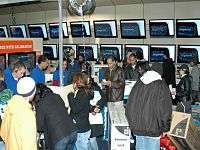Consumer electronics
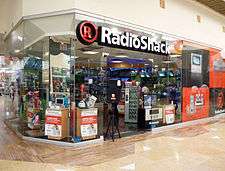
Consumer electronics or home electronics are electronic or digital equipment intended for everyday use, typically in private homes. Consumer electronics include devices used for entertainment (flatscreen TVs, DVD players, DVD movies, iPods, video games, remote control cars, etc.), communications (telephones, cell phones, e-mail-capable laptops, etc.), and home-office activities (e.g., desktop computers, printers, paper shredders, etc.). In British English, they are often called brown goods by producers and sellers, to distinguish them from "white goods" such as washing machines and refrigerators.[1][n 1] In the 2010s, this distinction is not always present in large big box consumer electronics stores, such as Best Buy, which sell both entertainment, communications, and home office devices and kitchen appliances such as refrigerators. Consumer electronics stores differ from professional audio stores in that the former sells consumer-grade electronics for private use, whereas the latter sells professional-grade electronics designed for use by audio engineers and audio technicians.
Radio broadcasting in the early 20th century brought the first major consumer product, the broadcast receiver. Later products included telephones, personal computers, MP3 players, audio equipment, televisions (first cathode ray tube TVs, then in the 2000s, flatscreen TVs) and calculators. In the 2010s, consumer electronics stores often sell GPS, automotive electronics (car stereos), video game consoles, electronic musical instruments (e.g., synthesizer keyboards), karaoke machines, digital cameras, and video players (VCRs in the 1980s and 1990s, followed by DVD players and Blu-ray disc players). Stores also sell digital cameras, camcorders, cell phones, and smartphones. As of 2016, some of the newer products sold include virtual reality head-mounted display goggles, smart home devices that connect home devices to the Internet (such as smartphone-controllable thermostats and lights) and wearable technology such as Fitbit digital exercise watches.
In the 2010s, most products have become based on digital technologies, and have largely merged with the computer industry in what is increasingly referred to as the consumerization of information technology. Some consumer electronics stores, such as Best Buy have also begun selling office and baby furniture. Consumer electronics stores may be "bricks and mortar" physical retail stores, online stores, where the consumer chooses items on a website and pays online (e.g, Amazon). or a combination of both models (e.g., Best Buy has both bricks and mortar stores and an e-commerce website for ordering its products). The CEA (Consumer Electronics Association) estimated the value of 2015 consumer electronics sales at US$220 billion.[3]
History
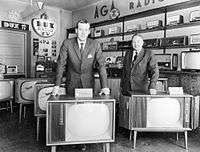
For its first fifty years the phonograph turntable did not use electronics; the needle and soundhorn were purely mechanical technologies. However, in the 1920s radio broadcasting became the basis of mass production of radio receivers. The vacuum tubes that had made radios practical were used with record players as well, to amplify the sound so that it could be played through a loudspeaker. Television was soon invented, but remained insignificant in the consumer market until the 1950s. The transistor, invented in 1947 by Bell Laboratories, led to significant research in the field of solid-state semiconductors in the early 1950s. The transistor's advantages revolutionized that industry along with other electronics. By 1959 Fairchild Semiconductor had introduced the first planar transistor from which come the origins of Moore's Law.[4] Integrated circuits followed when manufacturers built circuits (usually for military purposes) on a single substrate using electrical connections between circuits within the chip itself. Bell's invention of the transistor and the development of semiconductors led to far better and cheaper consumer electronics, such as transistor radios, televisions, and by the 1980s, affordable video game consoles and personal computers that regular middle class families could buy.
| “ | When we were patenting this [planar transistor] we recognized it was a significant change, and the patent attorney asked us if we really thought through all the ramifications of it. And we hadn't, so Noyce got a group together to see what they could come up with and right away he saw that this gave us a reason now you could run the metal up over the top without shorting out the junctions, so you could actually connect this one to the next-door neighbor or some other thing. – Gordon Moore | ” |
.
Products
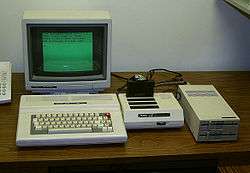
Main consumer electronics products include radio receivers, television sets, MP3 players, video recorders, DVD players, digital cameras, camcorders, personal computers, video game consoles, telephones and mobile phones.[5] Increasingly these products have become based on digital technologies, and have largely merged with the computer industry in what is increasingly referred to as the consumerization of information technology such as those invented by Apple Inc. and MIT Media Lab.
Trends

One overriding characteristic of consumer electronic products is the trend of ever-falling prices. This is driven by gains in manufacturing efficiency and automation, lower labor costs as manufacturing has moved to lower-wage countries, and improvements in semiconductor design.[6] Semiconductor components benefit from Moore's Law, an observed principle which states that, for a given price, semiconductor functionality doubles every two years.
While consumer electronics continues in its trend of convergence, combining elements of many products, consumers face different decisions when purchasing. There is an ever increasing need to keep product information updated and comparable, for the consumer to make an informed choice. Style, price, specification, and performance are all relevant. There is a gradual shift towards e-commerce web-storefronts.
Many products include Internet connectivity using technologies such as Wi-Fi, Bluetooth, EDGE or Ethernet. Products not traditionally associated with computer use (such as TVs or Hi-Fi equipment) now provide options to connect to the Internet or to a computer using a home network to provide access to digital content. The desire for high-definition (HD) content has led the industry to develop a number of technologies, such as WirelessHD or ITU-T G.hn, which are optimized for distribution of HD content between consumer electronic devices in a home.
Manufacturing

Many consumer electronics are built in China, due to maintenance cost, availability of materials, quality, and speed as opposed to other countries such as the United States.[7] Cities such as Shenzhen have become important production centres for the industry, attracting many consumer electronics companies such as Apple Inc.[8]
Electronic component
An electronic component is any basic discrete device or physical entity in an electronic system used to affect electrons or their associated fields. Electronic components are mostly industrial products, available in a singular form and are not to be confused with electrical elements, which are conceptual abstractions representing idealized electronic components.
Software development
Consumer electronics such as personal computers use various types of software. Embedded software is used within some consumer electronics, such as mobile phones.[9] This type of software may be embedded within the hardware of electronic devices.[10] Some consumer electronics include software that is used on a personal computer in conjunction with electronic devices, such as camcorders and digital cameras, and third-party software for such devices also exists.
Standardization
Some consumer electronics adhere to protocols, such as connection protocols "to high speed bi-directional signals".[11] In telecommunications, a communications protocol is a system of digital rules for data exchange within or between computers.
Trade shows
The Consumer Electronics Show (CES) trade show has taken place yearly in Las Vegas, Nevada since its foundation in 1973. The event, which grew from having 100 exhibitors in its inaugural year to more than 3,600 exhibitors in its 2014 edition, features new consumer electronics and speeches by industry pioneers.[12]
IEEE initiatives
Institute of Electrical and Electronics Engineers (IEEE), the world's largest professional society, has many initiatives to advance the state-of-the art of consumer electronics. IEEE has a dedicated society of thousands of professionals to promote CE, called the Consumer Electronics Society (CESoc).[13] IEEE has multiple periodicals and international conferences to promote CE and encourage collaborative research and development in CE. The flagship conference of CESoc, called IEEE International Conference on Consumer Electronics (ICCE), is on its 35th year.
- IEEE Transactions on Consumer Electronics[14]
- IEEE Consumer Electronics Magazine[15]
- IEEE International Conference on Consumer Electronics (ICCE)[16]
Retailing
Electronics retailing is a significant part of the retail industry in many countries. In the United States, big-box store retailers include Best Buy and Sears, with Best Buy being the largest consumer electronics retailer in the country.[17] Broad-based retailers, such as Wal-Mart and Target, also sell consumer electronics in many of their stores.[17] In April 2014, retail e-commerce sales were the highest in the consumer electronic and computer categories as well.[18] Some consumer electronics retailers offer extended warranties on products with programs such as SquareTrade.[19]
An electronics district is an area of commerce with a high density of retail stores that sell consumer electronics.[20]
Industries
The electronics industry, especially meaning consumer electronics, emerged in the 20th century and has now become a global industry worth billions of dollars. Contemporary society uses all manner of electronic devices built in automated or semi-automated factories operated by the industry.
Mobile phone industry
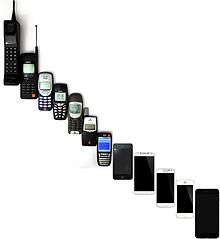
By country
Service and repair
Consumer electronic service can refer to the maintenance of said products. When consumer electronics have malfunctions, they may sometimes be repaired.
In 2013 in Pittsburgh, Pennsylvania, the increased popularity in listening to sound from analog audio devices, such as record players, as opposed to digital sound, has sparked a noticeable increase of business for the electronic repair industry there.[21]
Environmental impact
Energy consumption
The energy consumption of consumer electronics and their environmental impact, either from their production processes or the disposal of the devices, is increasing steadily. EIA estimates that electronic devices and gadgets account for about 10%-15% of the energy use in American homes – largely because of their number; the average house has dozens of electronic devices.[22] The energy consumption of consumer electronics increases – in America and Europe - to about 50% of household consumption, if the term is redefined to include home appliances such as refrigerators, dryers, clothes washers and dishwashers.
Standby power
Standby power – used by consumer electronics and appliances while they are turned off – accounts for 5–10% of total household energy consumption, costing $100 annually to the average household in the United States.[23] A study by United States Department of Energy's Berkeley Lab found that a videocassette recorders (VCRs) consume more electricity during the course of a year in standby mode than when they are used to record or playback videos. Similar findings were obtained concerning satellite boxes, which consume almost the same amount of energy in "on" and "off" modes.[24]
A 2012 study in the United Kingdom, carried out by the Energy Saving Trust, found that the devices using the most power on standby mode included televisions, satellite boxes and other video and audio equipment. The study concluded that UK households could save up to £86 per year by switching devices off instead of using standby mode.[25] A report from the International Energy Agency in 2014 found that $80 billion of power is wasted globally per year due to inefficiency of electronic devices.[26] Consumers can reduce unwanted use of standby power by unplugging their devices, using power strips with switches, or by buying devices that are standardized for better energy management, particularly Energy Star marked products.[23]
Electronic waste
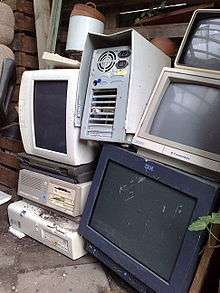
Electronic waste describes discarded electrical or electronic devices. Many consumer electronics may contain toxic minerals and elements,[27] and many electronic scrap components, such as CRTs, may contain contaminants such as lead, cadmium, beryllium, mercury, dioxins, or brominated flame retardants. Electronic waste recycling may involve significant risk to workers and communities and great care must be taken to avoid unsafe exposure in recycling operations and leaking of materials such as heavy metals from landfills and incinerator ashes. However, large amounts of the produced electronic waste from developed countries is exported, and handled by the informal sector in countries like India, despite the fact that exporting electronic waste to them is illegal. Strong informal sector can be a problem for the safe and clean recycling.[28]
Human rights abuses in manufacturing
Columbite-tantalite (or coltan, the colloquial African term) is the metal ore from which the element tantalum is extracted. Tantalum is used primarily for the production of tantalum capacitors, particularly for applications requiring high performance, a small compact format and high reliability, from hearing aids and pacemakers, to airbags, GPS, ignition systems and anti-lock braking systems in automobiles, through to laptop computers, mobile phones, video game consoles, video cameras and digital cameras.[29] It is largely extracted from the eastern Congo, and passed through a variety of intermediaries before being purchased by multinational electronics companies. These minerals are essential in the manufacture of a variety of devices, including consumer electronics such as mobile phones, laptops, and MP3 players.[30] A report filed with the SEC for Tulane University in New Orleans and Assent Compliance, a New York consulting firm found that about 90 percent of the 1,262 companies that filed the required conflict mineral disclosures in 2014 said they couldn’t determine whether their products were conflict-free. Two-thirds of the companies, including Google and Amazon, did not list the country of origin of their metals. Only 314 companies, less than 24 percent, complied with the Dodd-Frank Wall Street Reform and Consumer Protection Act mandate. [31]
Notes
- ↑ "Brown" from the bakelite and wood-veneer finishes typical on 1950s and 1960s radio and TV receivers, and in contrast to "white goods" like washing machines and refrigerators.[2]
See also
- Digital electronics
- List of home appliances
- Product teardown
- Timeline of electrical and electronic engineering
References
- ↑ "brown goods". Collins English Dictionary. Retrieved 5 December 2014.
- ↑ McDermott, Catherine (30 October 2007). Design: The Key Concepts. Routledge. p. 234. ISBN 9781134361809. Retrieved 5 December 2014.
- ↑ CEA: Industry Sales Data
- ↑ Schaller, Bob (26 September 1996). "The Origin, Nature, and Implications of Moore's Law. The Benchmark of Progress in Semiconductor Electronics". Microsoft Research.
Moore viewed the 1959 innovation of the planar transistor as the origin of "Moore's Law.
- ↑ "Consumer Electronics Manufacturing Industry Overview". Hoover's. Retrieved 9 September 2014.
- ↑ Mike Deng (23 October 2012). "China Moves to Automate Electronics Manufacturing". Quality Digest. Retrieved 11 June 2013.
- ↑ Baker, Phil (11 August 2014). "Why can't the US build consumer electronic products?". San Diego Source. Retrieved 9 September 2014.
- ↑ Gamble, Craig (22 August 2014). "Shenzhen in China becomes a power source for the electronics industry". Brisbane Times. Retrieved 9 September 2014.
- ↑ Hachman, Mark (4 September 2014). "Microsoft announces two Lumia phones, always-on Cortana, and clever new mobile accessories". PC World. Retrieved 11 September 2014.
- ↑ "Electronics hardware consumption poised to touch *360 bln by 2015". One India. 13 April 2008. Retrieved 11 September 2014.
- ↑ "Signal Converter of Consumer Electronics Connection Protocols (US 20120287942 A1)". IFI CLAIMS Patent Services. 15 November 2012. Retrieved 12 September 2014.
- ↑ Hornyak, Tim (2 September 2014). "Jack Wayman, founder of CES trade show, dies at 92". PC World. Retrieved 9 September 2014.
- ↑ IEEE Consumer Electronics Society, http://cesoc.ieee.org/
- ↑ Simon Sherratt, Editor-in-Chief (EiC), IEEE Transactions on Consumer Electronics, http://cesoc.ieee.org/publications/ieee-transactions-on-consumer-electronics.html.
- ↑ Saraju P. Mohanty, Editor-in-Chief (EiC), IEEE Consumer Electronics Magazine, http://cesoc.ieee.org/publications/ce-magazine.html.
- ↑ IEEE International Conference on Consumer Electronics (ICCE), http://www.icce.org/
- 1 2 Murphy, H. Lee (27 January 2014). "Why consumer electronics retailers are the next record store". Crain's Chicago Business. Retrieved 11 September 2014.
- ↑ eMarketer (11 April 2014). "US Retail Ecommerce Sales Highest for Computers, Consumer Electronics". The Huffington Post. Retrieved 11 September 2014.
- ↑ Sherman, Erik (19 December 2011). "Hold off extended warranties until you read this". CBS News (Moneywatch). Retrieved 11 September 2014.
- ↑ Cellan-Jones, Rory (8 December 2012). "Look round Shenzhen's Electronics District". BBC News. Retrieved 20 July 2016.
- ↑ Todd, Deborah M. (18 August 2013). "Electronic repair industry gets second wind". Pittsburgh Post-Gazette. Retrieved 11 September 2014.
- ↑ "Heating and cooling no longer majority of US home energy use". EIA.gov
- 1 2 Chu, John (1 November 2012). "3 Easy Tips to Reduce Your Standby Power Loads". Energy.gov. United States Department of Energy. Retrieved 10 September 2014.
- ↑ Lippert, John (17 August 2009). "Please Stand By: Reduce Your Standby Power Use". Energy.gov. United States Department of Energy. Retrieved 10 September 2014.
- ↑ Harvey, Fiona (26 June 2012). "Leaving appliances on standby 'can cost UK households up to £86 a year'". The Guardian. Retrieved 9 September 2014.
- ↑ Carr, Matthew (2 July 2014). "Electronic Devices Waste $80 Billion of Power a Year, IEA Says". Bloomberg L.P. Retrieved 9 September 2014.
- ↑ Moreno, Julia (8 September 2014). "Normal is recycling out-of-date electronics". Vidette Online. Illinois State University. Retrieved 9 September 2014.
- ↑ Bhowmick, Nilanjana (23 May 2011). "Is India's E-Waste Problem Spiraling Out of Control?". Time. Retrieved 14 September 2014.
- ↑ "Tantalum – Raw Materials and Processing". Tantalum-Niobium International Study Center. Archived from the original on 16 December 2010. Retrieved December 16, 2010.
- ↑ Dias, Elizabeth (24 July 2009). "First Blood Diamonds, Now Blood Computers?". Time. Time Warner. Archived from the original on 16 December 2010. Retrieved December 16, 2010.
- ↑ Morgan Winsor (September 18, 2015). "Congo's Conflict Minerals: US Companies Struggle To Trace Tantalum, Tungsten, Tin, Gold In Their Products". International Business Times.
Further reading
- Kevin Sintumuang (2 January 2015). "Tech Etiquette: 21 Do's and Don'ts". The Wall Street Journal.
